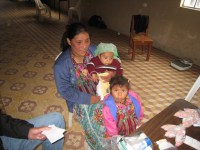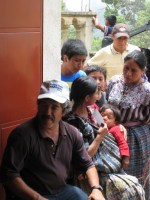I’m decompressing from a week with the Maya people in Patzun, Guatemala. From living in the quiet solitude of a Carmelite convent and visiting gentle people in simple villages, I’ve returned to the sensory overload that is life in these United States. It’s quite an adjustment.
It didn’t help that I returned home to a moldy, soggy mess in the form of two front bedrooms flooded from an outside drainage problem. I just wasn’t ready to deal with moving everything out of those rooms (full of my late father-in-law’s books and junk) to rip up carpet and scrub. But I’ve been able to contain my resentment of this interruption to my plans by putting it in perspective based on where I’ve just been.
Point of reference: I live in a 3,200 square foot house with three bedrooms, three bathrooms, three living areas, a huge kitchen and two dining spaces. There’s a big shady yard, patio and pool. Sure, it’s the old, neglected, 1969 ranch we inherited from Bill’s dad, it’s got foundation problems, the original 1969 wallpaper and carpet, and a vintage kitchen with countertops the color of Post-it notes, but it’s home, and the floor plan is perfect. I’m looking forward to fixing it up, decorating it to our liking, and returning to my old habits of entertaining our diverse group of friends.

Most of the people I met in Guatemala are poor sharecroppers, making $2-$3 a day. I’m not sure what the women make weaving and embroidering traditional garments, but they all seem to have between 5 and 12 kids, no access to healthcare, and no real opportunity for economic advancement in remote mountain villages devoid of infrastructure or industry. More than one family could live in my house in Denton, as awful as I think it is, and probably think they’re living the high life.

The really nice houses are concrete block, most likely with a concrete slab floor, and rebar sticking out of the roof in optimistic anticipation of a second floor someday in the future. I’m pretty sure indoor plumbing is rare, and most roofs are corrugated metal. Everybody cooks on a wood stove. I’m told they sleep on mats on the floor, and when it’s cold there’s little or no heat in the homes. Other homes are made of bamboo or wood (and sometimes cornstalks) stacked kind of like log cabins, with mud chinking betweeen. They undoubtedly have a dirt floor.
My resentment at spending several days cleaning out two rooms I almost never use is a little out of place, considering that the vast majority of the people in the world don’t have extra rooms to stash junk they don’t use but can’t bear to part with. I’ve seen people living in grass and mud huts in Africa, ramshackle dwellings in India and Thailand, adobe and tin homes in Mexico and Venezuela, and plenty of urban and rural poverty in the United States. But I’ve never experienced poverty at this level. It’s everywhere in Guatemala. Meeting the people, seeing the villages, and experiencing how poor they are is not the same as speeding by on the tour bus, looking on and saying “How awful people have to live that way.”

When you see people line up and wait patiently for their turn with the nurse practitioner to discuss their baby’s ear infection, their anxiety and inability to sleep, or their aching joints from long hours in the fields, you can empathize. But there’s no Walgreens on the corner to buy a bottle of Tylenol, no CVS Minute Clinic to get a prescription for Amoxicillin. And if there was, what would you pay with? $2 a day won’t buy many Advil anywhere, especially in a country that does not allow generic drugs because they have no FDA for quality control.

We did the best we could. Jean, our nurse practitioner, refers to these clinics as “comfort meds.” Our little mobile pharmacy dispensed antibiotics, anti-parasite drugs, and basic diabetes and high blood pressure meds. People with sleep problems received Benadryl. Pregnant women received a “pregnancy pack” consisting of Tums (for calcium), folic acid, multivitamins, and Tylenol for pain. Children also received vitamins, no matter what their complaint was. And we gave out Advil, Naprosyn and muscle rub to the aching farm workers who lined up near the end of each clinic.
Whenever I counted out something as simple as 30 Advil and prepared a package of muscle rub and gave it to an aching father, with an explanation of how to take it, I was struck by how grateful and gracious the response. When the baby had a fever and needed medicine, the mother waited patiently while we prepared everything, labeled it in Spanish and with a visual aid, then explained how to properly administer the drug. The response was always the same–a warm handshake, a gracious “Thank you” and “Veo a Dios en ti” which is “I see God in you.”

They have no idea that most of us have a stash of painkillers at home and in the office, and often in our purse or backpack. We have family doctors, specialists and extended hours clinics to help us with myriad medical complaints. They have missionaries who periodically appear from a faraway land to provide limited help. A simple over the counter medicine is a wonderful gift of love and comfort from a stranger who’s come from far away just to make their life a tad more comfortable. They are so appreciative of things we take for granted. Are we that appreciative of our gifts? I never really saw any complaints–these people are poor and have a hard life, but they have tremendous faith in God, love their children and their families, and always have a smile to share.
Last night, after moving furniture and ripping out wet carpet, I took my glass of wine out to the backyard hot tub to soak my sore muscles. When do these hard working souls ever get that chance?

I gave out medicine, toys, candy and smiles in Patzun. I know the little girl I gave the jump rope to will love and appreciate it for a long time. But she gave me a gift I’ll cherish forever–a new appreciation for the simple things, for a smile and a hug from a friend or a kind stranger. She, and all the people I met, really helped me appreciate how good I’ve got it–even if I think my life has been really rotten these last couple of years–and how good it can be with just the love of friends and family and faith and trust in God. All the whiners and haters and complainers in the USA would do well to spend quality time with the people I just spent a week with. Maybe their hard-hearted attitudes will soften toward those less fortunate than themselves, and they’ll be less divisive and mean in their speech and actions. We can only hope.
The last patient haunts me. We had packed everything up after seeing about 40 patients and administering antiparasite medicine to 250 kids at the school in El Sitio. Our lunch finished, we were seated in the van, ready for the long, rainy drive home, when Miriam, our Mayan interpreter, asked if we could see a baby. No telling how far this mother had walked in the cold rain with this sick baby, but the child had suffered from diarrhea for 15 days. Of course, we unpacked, Jean examined the child, and we dug out rehydration salts and Bactrim suspension from our drug boxes to give to the baby. But 15 days is a long time for anybody to have diarrhea, and I still wonder about that little baby and whether or not it makes it.
The gifts I received from my brief stay in Guatemala are incalculable and intangible, and much greater than those I gave. As a skilled wordsmith, I’m still seeking the words to describe this experience. I do intend to return. Maybe the Holy Spirit will inspire me with the words necessary to describe the change this experience has made in my life.
For the St. Mark Catholic Church blog on Guatemala, check out http://stmarkguatemala.blogspot.com/
(c) Samra Jones Bufkins, July 3, 2010.











